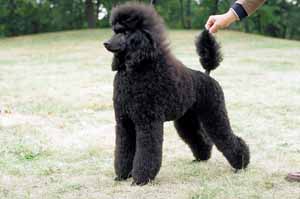


Photo courtesy of AKC. For more information on 153 AKC recognized breeds, visit www.akc.org
One of the brightest breeds, poodles are energetic, playful and affectionate. Standard poodles are more easy-going around children than toy or miniature poodles, and get along well with other animals. They are eager to please and adapt well to city life as long as they get plenty of exercise and social interaction.
Breed-related concerns
Every dog breed carries a distinct set of genetic advantages and health risk factors. The following are the most common diseases found in the Standard Poodle breed. Hopefully, your standard poodle will not face these problems. However, early detection and preventive healthcare can make all the difference in helping your dog live a longer, happier life (see breed-related disease descriptions below).
Puppy (birth to 1 year)*
Adult (1 to 6 years)*
Senior (7 years and older)*
Breed-related disease descriptions
Listed in alphabetical order. *Please note that these common diseases can occur earlier or later in the dog’s life.
Addison’s disease. A disease caused by a lack of cortisol (a steroid) production of the adrenal glands. Symptoms include lethargy, weakness, decreased appetite, vomiting, diarrhea, weight loss, collapse and pale mucus membranes.
Developmental bone/joint disease. Includes abnormal development and arthritis of the hip joint (called hip dysplasia in large-breed dogs and Legg-Perthe’s disease in small-breed dogs); elbow joint (elbow dysplasia); shoulder, knee, or ankle joint (osteochrondritis dissecans or OCD). Affects predominantly young (It starts in young dogs, but a lot of the time it is not evident until the dog is older), large-breed dogs. Dogs may show no signs or may show pain, lameness, and reluctance to exercise. With hip dysplasia, there may be muscle wasting in the hind legs.
Ear infections (Otitis externa). Infection or inflammation of the ear canal. May be due to bacterial, yeast or ear mite infection, foreign bodies, allergies or hormonal disorders. Signs may include head shaking, smelly ears, scratching and rubbing of ears, reddening of the ear flap, discharge from ears, and pain on touching around the ears.
Gastric dilation-volvulus (bloat). A sudden, life-threatening condition due to abnormal twisting of the stomach. Signs include dramatic abdominal distention (bloating), attempts to vomit (with nothing brought up), pain in the abdomen, weakness and collapse (shock).
Hypothyroidism. Insufficient thyroid hormone production caused by disease of the thyroid glands. Symptoms include hair loss, obesity, lethargy, cold intolerance and skin infections.
Sebaceous adenitis. Dandruff, hair thinning and hair loss due to disease and destruction of sebaceous (oil producing) glands in the skin.
Help your dog live a longer, healthier life. Ask your veterinarian about a breed-related preventive health plan.